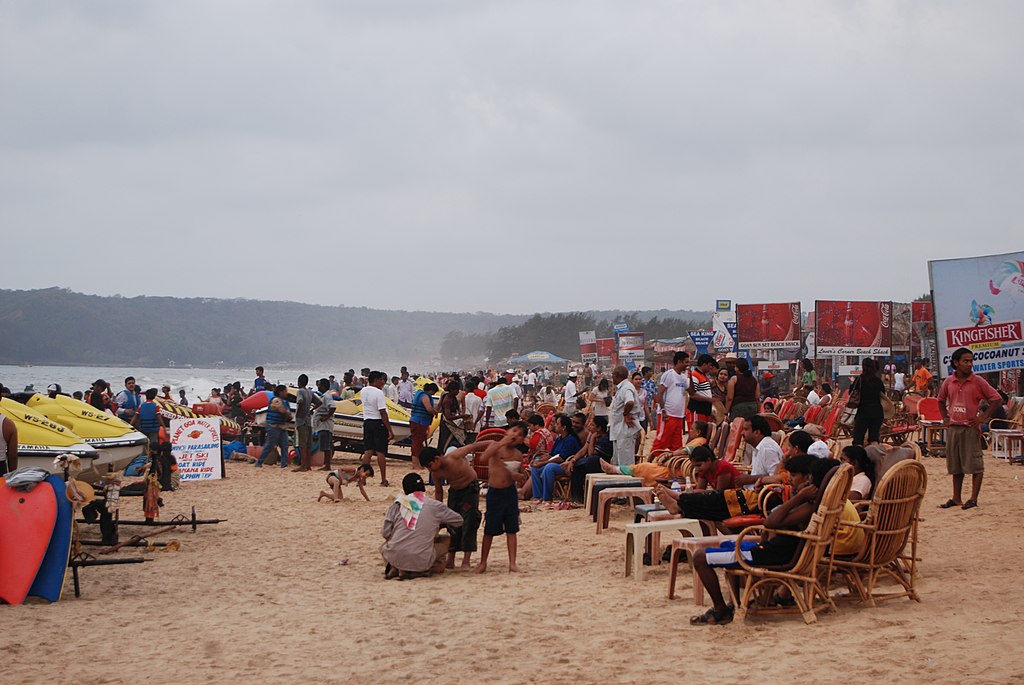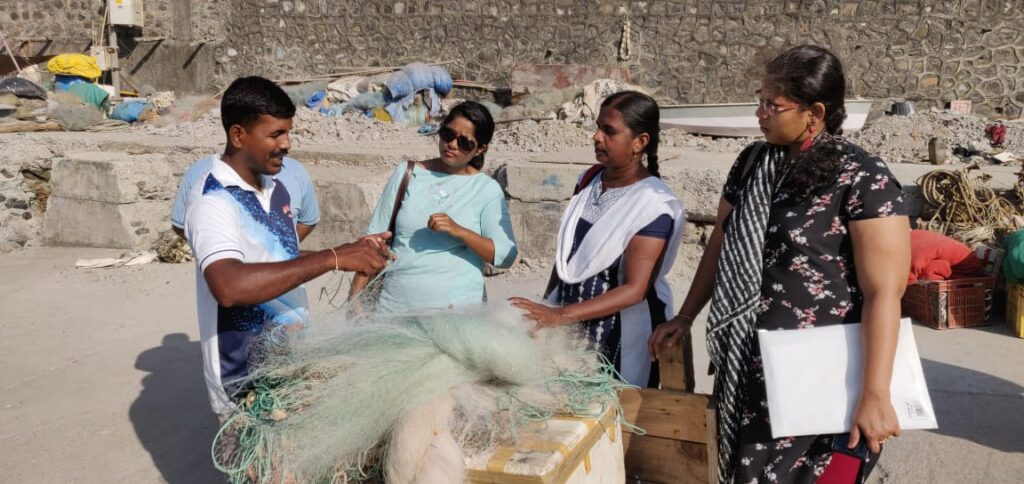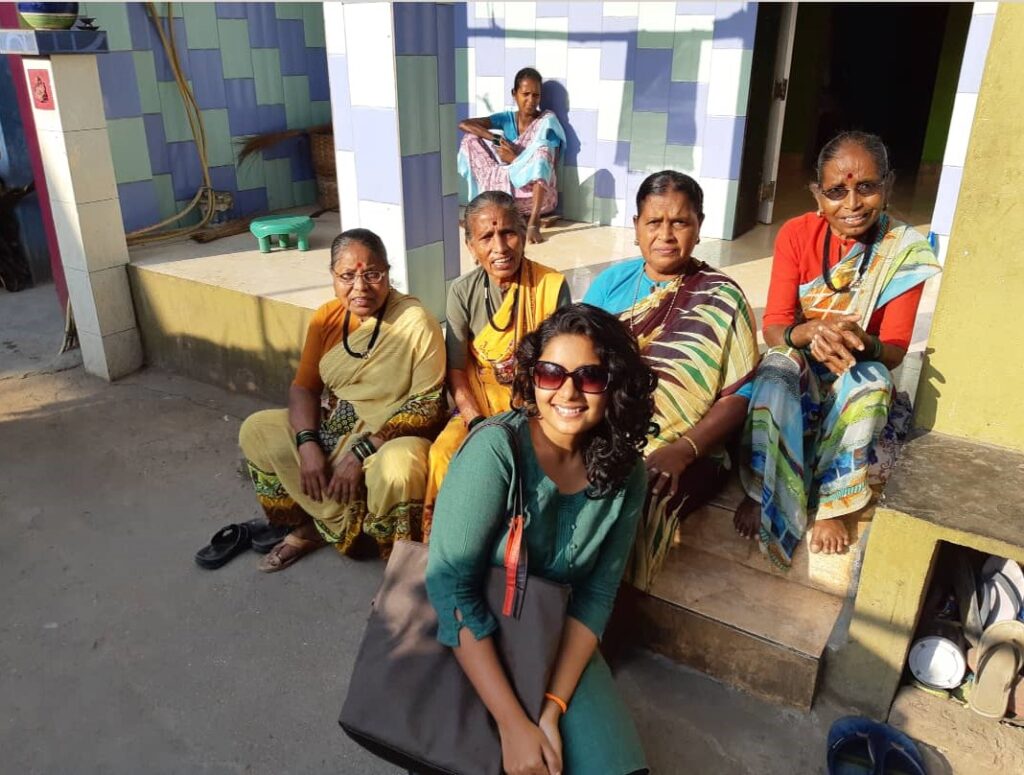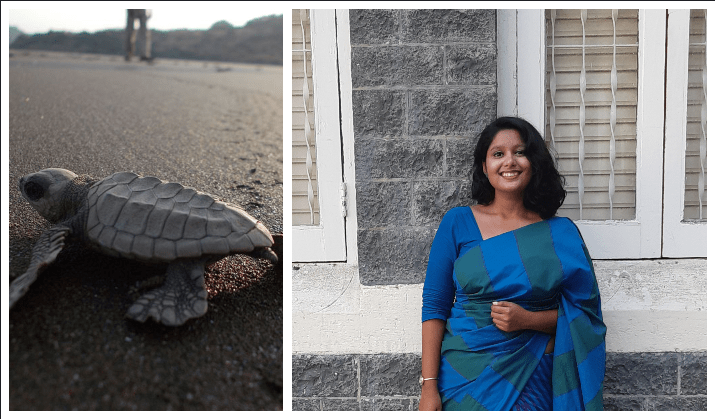A lot is happening in marine and coastal conservation. Mumbai plans to build a coastal road. There are talks of banning trawling, and at the same time, there is a big push for commercial fishing by the government. Yet, there seems to be disproportionate attention paid to these big-ticket issues by the media, as well as by researchers. “When we don’t have research, evidence, and data, how will we advocate for marine and coastal conservation?” questions Sarita Fernandes (SF), a marine and coastal policy researcher based in Goa.
Sarita, 24, has been working on bottom-up, grassroots level marine wildlife conservation, and coastal land-use conservation. She graduated with a Masters in Public Policy from St. Xavier’s College Mumbai, where her thesis was titled “A critique of the coastal regulation zone notification (CRZ) with respect to coastal land use in Mumbai and Greater Mumbai.” Her work covers projects on turtle nesting sites, inter-tidal marine biodiversity, shark fin trade, and traditional coastal community outreach and capacity building. She strongly believes in engaging local communities in conservation dialogues and policies, and in this interview gives a fascinating peek into the lives of fishing communities and those living around marine wildlife habitats. Sarita also headed the Morjim Sea Turtle Festival, an awareness and outreach project on the turtle nesting beach of Morjim, in North Goa.
In conversation with Vaishnavi Rathore (VR), Sarita talks about research in marine conservation, the threat of commercial fishing, and loopholes in coastal conservation policies.
VR: In the current environment discourse, do you think that marine and coastal conservation receive as much attention as other sub-sectors?
SF: In India and abroad, compared to terrestrial conservation, there is very clearly disproportionately less attention paid to coastal and marine conservation. One reason is that there are still not enough researchers to study the issues affecting the sector.
Even when there is research, there are limitations. For instance, those who work on coastal communities many times use an interdisciplinary approach, where the researcher is probably studying the economics of fishing industries. Hence, they would happen to research the coastal communities too, because they form an integral part of this economic framework. But, we still don’t have people specialising their research solely on the communities with the intent of researching them alone.
In fact, the only people studying coastal areas seem to be the government, that too only when they are developing their own projects, like the coastal road project in Mumbai!
The coastal road, a dream project of @CMOMaharashtra Uddhav Thackeray ji, has been given the go ahead by the Hon’ble Supreme Court. It will benefit Mumbai at large and we are committed to time bound completion of the project by the @mybmc
— Aaditya Thackeray (@AUThackeray) December 17, 2019
The government does this through an Environment Impact Assessment (EIA) report. Even though EIAs are generally not great reports, they at least give us an idea of some baseline data. This baseline data is a good starting point for the coastal conservation sector, because most of the sites–like mangroves and wetlands–are not easily accessible. When it comes to logistics and access with respect to surveying coastal habitats, researchers face a lot of hurdles. So, this is why such studies on coastal areas are not conducted very often by non-government actors.
But, when we don’t have research, evidence, and data, how will we advocate for marine and coastal conservation?
Additionally, when talking about marine and coastal policies in this sector, another complication arises. Most of these policies in India, and even in other “developed” countries, are marred with loopholes.
VR: What kinds of loopholes?
SF: (Lingers for a few seconds and laughs lightly)…I’m just thinking of which loophole example to give you! Here is one–The Coastal Regulation Zone Notification divides coastal zones into four categories, where CRZ1(i) covers the most ecologically sensitive coastal areas that require the highest form of coastal protection. So, you would find turtle- and sea bird-nesting beaches fall under this category. But then in the policy, when it comes to prohibited activities within these zones, there are exceptions made that are counterproductive to protection. They range from construction, to the expansion of foreshore facilities like ports, bridges, sealinks, and roads-on-stilts. So, these exceptions completely beat the purpose of the Coastal Regulation Zone Notification in the first place!
VR: When it comes to coastal areas, from the Government’s end, there seems to be a lot of push towards tourism. How has this impacted the communities?
SF: The focus on tourism in the coasts of our country has been a result of simply following the Western development model, which is the easiest way to help an indigenous community earn a livelihood. While this is an important outcome, there is no doubt that the tourism models we’re developing need to be executed sustainably.

I will give an example. The last project I worked on before the lockdown was the sea turtle conservation project in Morjim, with the Goa Forest Department. Around 10 years ago, the government decided to market the beaches of Morjim and Arambol as tourist destinations even more, especially catering to Russian tourists. Today, almost 90% of the Russian charter tourists who visit Morjim also live here during their visit. And, they obviously like to spend their time on the beach. The locals, in the absence of any directions on how to make this a sustainable model, decided to attract as many tourists as possible. This was done by building beach shacks and beach beds all over the beaches; sometimes, even all the way up to the ocean.
But, Morjim is also a turtle nesting site. With this rapidly expanding tourism, we saw instances of major disturbances to nesting patterns in the mother sea turtles. The strain on the natural resources here was massive. This issue was taken to the National Green Tribunal, where they slapped a fine of ₹1 crore on the Goa State Coastal Zone Management Authority (GCZMA) for letting temporary structures come up on the beaches without the requisite permissions.
What’s important to remember is that tourism can also act as a ‘good-cop-bad-cop’ catalyst in the case of conservation. While excessive tourism, if not developed sustainably can deteriorate the natural resource, tourism has also made the locals more conscious that cleanliness is important to keep the tourists coming. In some cases, to keep tourism alive, local communities have also prevented industrial development on the coasts.
VR: How do you think sustainable tourism can be promoted?
SF: It’s important to note that in such cases, the natural resource has more than one stakeholder dependent on it. In the Morjim case, it was the Olive Ridley sea turtles, as well as the community. We wanted to include the community along with the sea turtles in the dialogue of the beach.
So, we came up with a community conservation model. We came to a middle ground by asking the beach shacks to stack their beds at night, and to keep the lights and sound off post 7 pm. In response, we would promote their shack in our sea turtle conservation dialogue, by labelling it “turtle friendly”. Similar efforts can be taken up.
For the first time in seven years, olive ridley #turtles have been hatching in the daytime in India. Happy #TurtleTuesday! https://t.co/BeiPjG24Ko
— Ocean Conservation Research (@OceanNoise) May 20, 2020
VR: There have been talks about regulations on trawling in Indian oceans. What do you think of that?
SF: The fact that trawling is the most unsustainable form of fishing is backed by a lot of research. With the amount of trawling going on, the catch of fish retrieved is mostly juvenile, it’s not even a fully-grown catch [There are over 72,000 mechanised fishing boats across India, of which trawlers comprise 49%]. If I show you the size of an adult kingfish, you’d be surprised because most of the kingfish on your table are juveniles. At this rate of juvenile catching and consumption, these species will go extinct in the next 20 years!
‘Bycatch’ trawling is a source of the fast-growing Fish Meal and Fish Oil industry. This is leading to unsustainable fishing, not helped by government subsidies for fisheries which aid mechanised trawlers more than small-scale fishers. By @earthjournalism https://t.co/ZwpN2yok37
— Know Your Fish (@knowyourfish) May 26, 2020
A policy regulating the phasing out of bottom trawling could be very beneficial. However, we are yet to see how this will play out–would there be licenses given to trawlers to regulate the practice? The government might also suggest changing the types of nets used, like having a bigger mesh, so that the smaller sized juvenile fish are not caught, or, they might encourage mid-water trawling [This type of trawling is done with a net in a column above the sea bed, so it doesn’t impact the seabed]. Or, on the other hand, are we looking at a complete ban of trawling altogether?
In theory and principle, I suppose midwater trawling could work, but in reality, I doubt if trawlers would actually want to shift towards this. Currently, the small scale fishers are involved in less than 7-day voyages within the sub-tidal zone [The area above water level at low tide and underwater at high tide] which is where shrimps and high-end lobsters are found. But, the trawling method of fishing, especially in the sub-tidal areas takes more than its fair share of catch, making it unsustainable and unfair to small scale and traditional fishers.
Australia implemented a similar policy, by banning “Super Trawlers”, which were 100 times the size of a regular trawler in 2012. While these super trawlers could have meant more money thanks to the larger catch, they would have generated profits only for limited voyages or fishing seasons. This is because this unsustainable fishing method catches much more fish than can be regenerated in the ocean. From the marine ecology, to the smaller fishermen, to even these smaller trawlers, everyone would have lost out in the long run.
Good News for Dolphins and Whales: Australia to Ban Super Trawlers http://t.co/CUUzYN260u by @TakePart pic.twitter.com/YjvvRsoPiX
— Eco Diva (@EcoDivaBeauty) January 1, 2015
VR: The larger problem then seems to be commercial fishing, and not just trawling. Would you agree?
SF: The complexity of the fisheries sector is that government initiatives often connect it with the agrarian sector, where more harvest means more money, and hence, more growth in the agrarian economy. The same logic is used in fisheries, where it is assumed that more fish would mean more money, and more growth in the fisheries sector. That’s why this year the government came up with a National Fisheries Policy 2020, with the clear intention of boosting commercial fisheries. The government seeks to do this through public-private-partnership models, to help the smaller-scale fishers transition into big scale businesses. This is a very big problem, because while this might mean more money for the fishers involved, the damage it will do to the ocean is huge and irrefutable.
Fisheries are much more complex than we realise, and need to be understood beyond the “more-money-capitalism-and-hence-growth” angle. We need to incorporate breeding times, the size of the nets, small-scale and traditional fishers, and many other factors into our policies for them to be truly holistic.
VR: Can examples of sustainable fishing be traced out from within the local fishing communities?
SF: Absolutely! The fishing community is very vibrant. Say, you get lobsters in one fishing village, the community there will glorify this produce by painting their houses with lobster designs!
Locals also have rules on the number of boats allowed in the sea every day from their village, and how many times a fisher can go to the sea with their net. Generally, these systems ensure that a single fisher does not over-exploit the fish in the ocean, by not letting others fish.

What makes this community even more structured are the “fishing societies” formed in each village. These societies are registered with the Fisheries Department. Several meetings are held in a month, where fishers and locals voice their concerns. If they are unable to address their concerns in this forum, they request assistance from the Fisheries Department where sometimes, conservationists like us also help.
Local fishing communities have been seen as important stakeholders but more focus on small scale fishers is needed. On the coastal shores of India, a ‘no development zone’ is demarcated; it begins from the high tide line, up to 500 metres on shores, protecting local settlements. The 2011 Coastal Regulation Zone Notification also acknowledged Koliwadas, or fishing villages, by listing them under CRZ III. This means that for any development taking place around this coastal zone, these fishing communities will be a direct stakeholder to any coastal development or plan in this area.
VR: What’s it like being a woman in the field of marine and coastal conservation?
SF: It’s not easy. I at least had a good opportunity, access to education, and a thesis to facilitate my entry into the field. But starting off has been tough, and as women, we have to deal with sexism and patriarchy.
I had to work in organisations that were not really organised, they were loosely knit conservation and grassroots NGOs. But, working with them was important because they have access to local communities and habitats. In this field, access to coastal communities is generally very limited.
The conservation sector also involves a lot of fieldwork. Often, you’ll be juggling busy fieldwork on one day, with a conference presentation the following day. You’ll often arrive at the conference and people will look at you with sympathy for turning up as a “tanned, slightly-tired looking woman”. But if it were a man, he would be praised for the same work, not sympathised with–“look at him, he just came back from the field and is doing a presentation today!” As women, we have to make sure that our game is A-level, both in terms of knowledge, and how we present ourselves.
Also, women are still not expected to take on autonomous leadership roles. In conservation specifically, I find that women are not looked at as people who can bandwagon their own organisations or institutions. Women can be promoted up the ladder and eventually become the Director of the same organisation. But, they’re rarely seen as capable of taking power and starting their own initiatives.

But, I derive motivation from the communities I work with. Fishing communities have very clearly demarcated roles for fisherwomen. The fisherwomen sell the fish, so they are the ones bringing in the income for the family. They also have some financial independence: using their savings, they buy and wear gold. So, anyone who would want to steal from them would have to literally steal from them physically! The ocean, too, is my motivation. She deals with pollution, overfishing, and is treated as an inexhaustible dustbin, but she fights to function.
So, as women, we will get through! Primatologist Jane Goodall was also one of the pioneers in impacting conservation, and look at what she and all other brilliant women in the field of wildlife and marine conservation were able to achieve. Ultimately the universe will balance the scales, till then we keep working on shattering that glass ceiling with the ocean as our ally.
Featured image courtesy of Sarita Fernandes and Pawar Pooja (CC BY-SA 4.0). | Views expressed are personal.







That was a great piece of information and definitely inspiring to work smartly!!
Now that’s a warrior right there!with the mighty ocean as her commanding officer, Sarita is the future of this living, breathing planet..a true “leader without a title”.
Kudos,thank you and godspeed to the team as well